Person-Centred Care: Implementation and Reflective Practice Report
VerifiedAdded on 2023/01/13
|11
|3337
|93
Report
AI Summary
This report provides a comprehensive analysis of person-centred practice within the National Health Service (NHS). It begins by comparing the application of medical and social models in person-centred care, emphasizing the importance of patient involvement and individual needs. The report then explores how a person-centred approach is implemented in program planning and execution, highlighting considerations such as physical support, cultural sensitivity, and confidentiality. It further examines the influence of various healthcare legislations and policies on the provision of person-centred care, including health and safety standards, safeguarding measures, and data protection. The report also addresses potential challenges in implementing these policies and offers solutions. A significant portion of the report includes a reflective account of the author's experiences within NHS, focusing on team dynamics, strengths, weaknesses, and areas for improvement. Finally, it presents a detailed action plan for enhancing personal skills and contributing to workplace effectiveness.
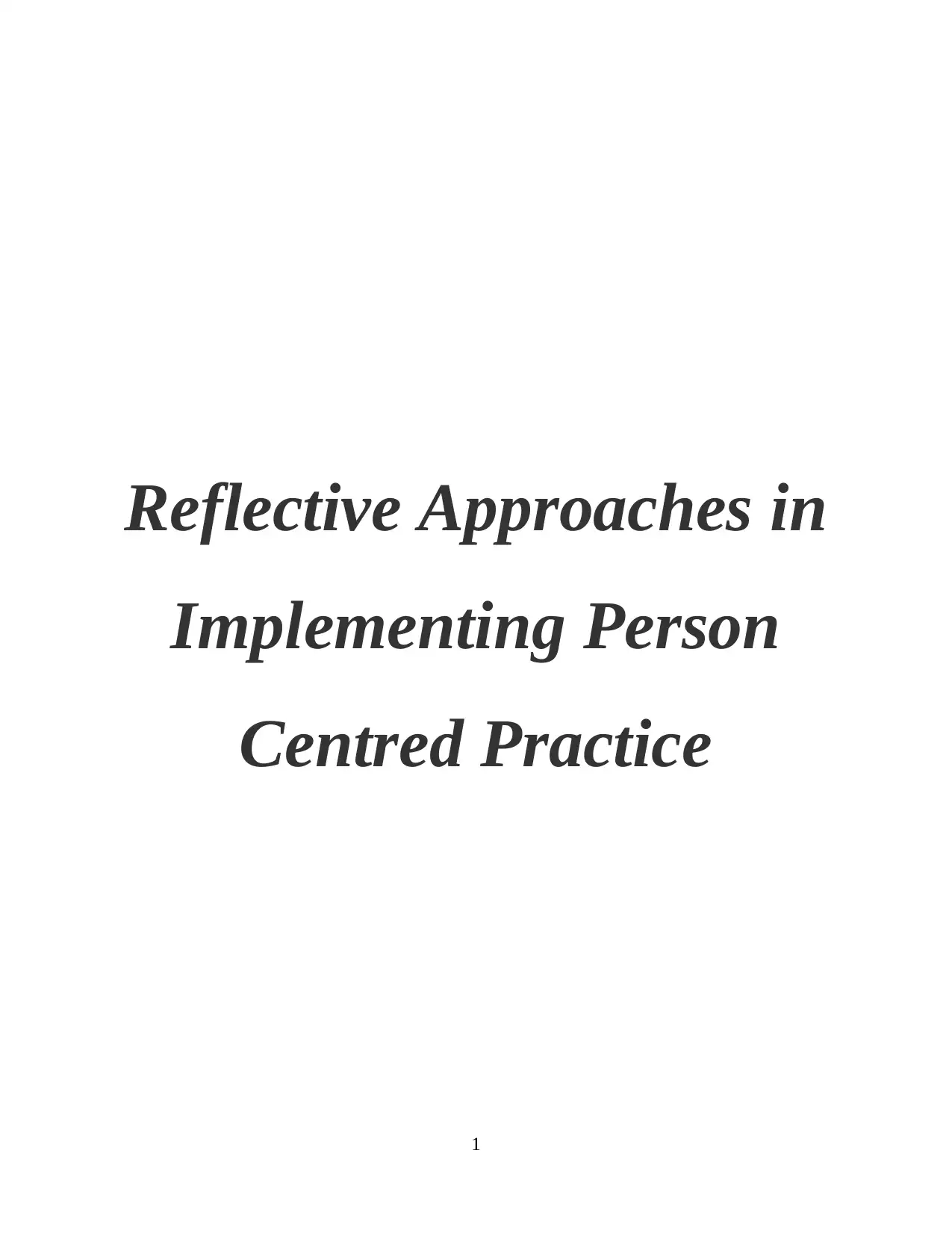
Reflective Approaches in
Implementing Person
Centred Practice
1
Implementing Person
Centred Practice
1
Paraphrase This Document
Need a fresh take? Get an instant paraphrase of this document with our AI Paraphraser
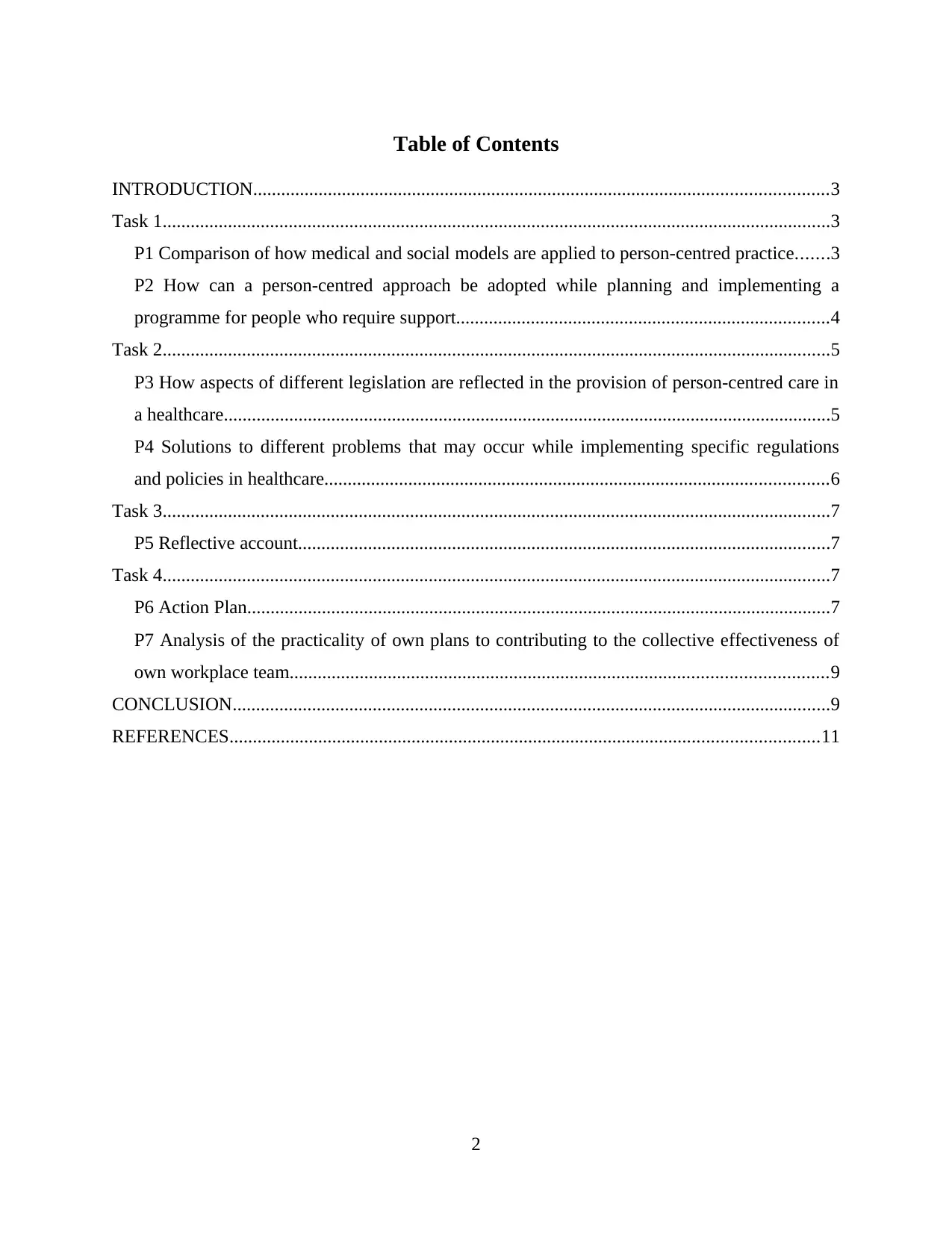
Table of Contents
INTRODUCTION...........................................................................................................................3
Task 1...............................................................................................................................................3
P1 Comparison of how medical and social models are applied to person-centred practice.......3
P2 How can a person-centred approach be adopted while planning and implementing a
programme for people who require support................................................................................4
Task 2...............................................................................................................................................5
P3 How aspects of different legislation are reflected in the provision of person-centred care in
a healthcare..................................................................................................................................5
P4 Solutions to different problems that may occur while implementing specific regulations
and policies in healthcare............................................................................................................6
Task 3...............................................................................................................................................7
P5 Reflective account..................................................................................................................7
Task 4...............................................................................................................................................7
P6 Action Plan.............................................................................................................................7
P7 Analysis of the practicality of own plans to contributing to the collective effectiveness of
own workplace team...................................................................................................................9
CONCLUSION................................................................................................................................9
REFERENCES..............................................................................................................................11
2
INTRODUCTION...........................................................................................................................3
Task 1...............................................................................................................................................3
P1 Comparison of how medical and social models are applied to person-centred practice.......3
P2 How can a person-centred approach be adopted while planning and implementing a
programme for people who require support................................................................................4
Task 2...............................................................................................................................................5
P3 How aspects of different legislation are reflected in the provision of person-centred care in
a healthcare..................................................................................................................................5
P4 Solutions to different problems that may occur while implementing specific regulations
and policies in healthcare............................................................................................................6
Task 3...............................................................................................................................................7
P5 Reflective account..................................................................................................................7
Task 4...............................................................................................................................................7
P6 Action Plan.............................................................................................................................7
P7 Analysis of the practicality of own plans to contributing to the collective effectiveness of
own workplace team...................................................................................................................9
CONCLUSION................................................................................................................................9
REFERENCES..............................................................................................................................11
2
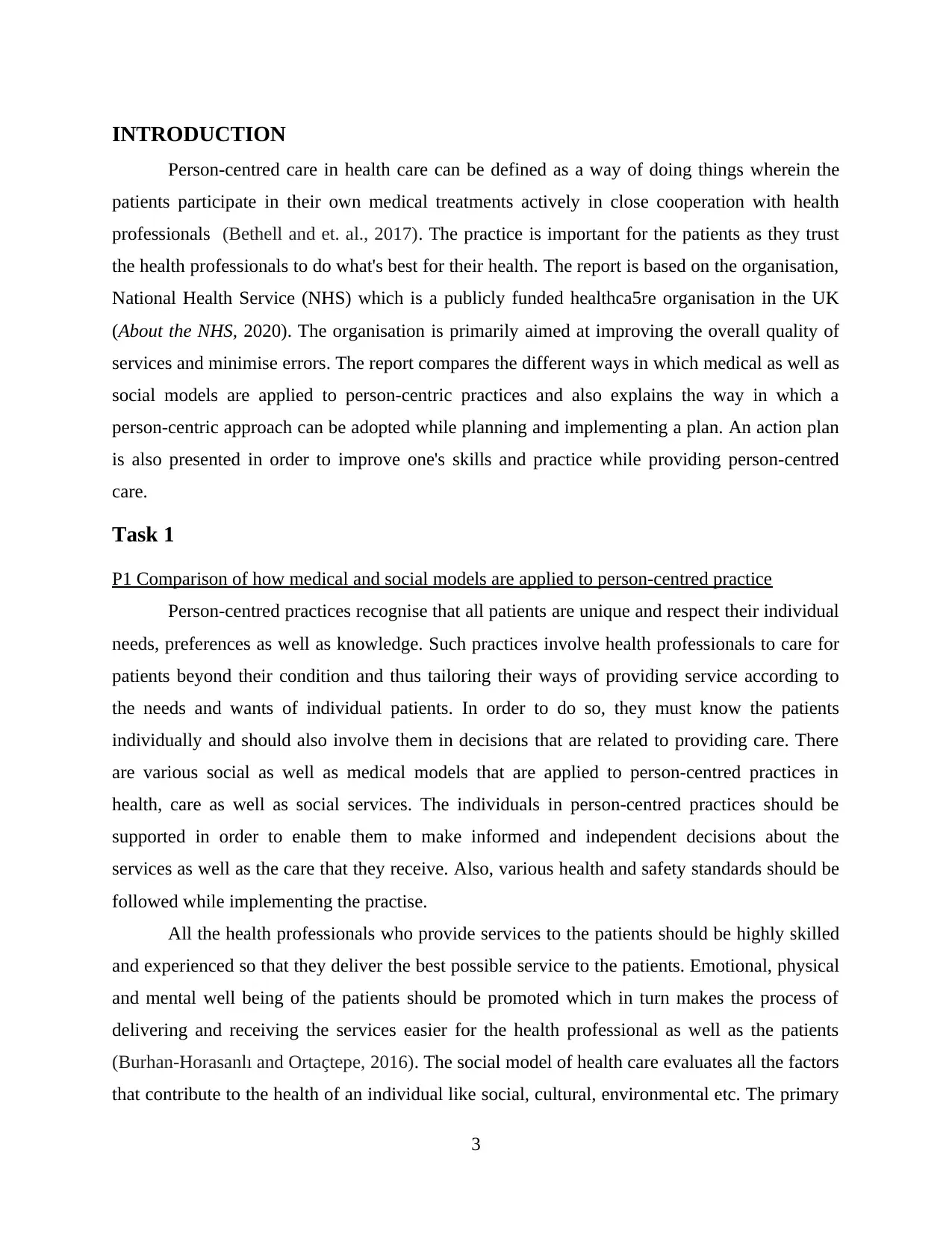
INTRODUCTION
Person-centred care in health care can be defined as a way of doing things wherein the
patients participate in their own medical treatments actively in close cooperation with health
professionals (Bethell and et. al., 2017). The practice is important for the patients as they trust
the health professionals to do what's best for their health. The report is based on the organisation,
National Health Service (NHS) which is a publicly funded healthca5re organisation in the UK
(About the NHS, 2020). The organisation is primarily aimed at improving the overall quality of
services and minimise errors. The report compares the different ways in which medical as well as
social models are applied to person-centric practices and also explains the way in which a
person-centric approach can be adopted while planning and implementing a plan. An action plan
is also presented in order to improve one's skills and practice while providing person-centred
care.
Task 1
P1 Comparison of how medical and social models are applied to person-centred practice
Person-centred practices recognise that all patients are unique and respect their individual
needs, preferences as well as knowledge. Such practices involve health professionals to care for
patients beyond their condition and thus tailoring their ways of providing service according to
the needs and wants of individual patients. In order to do so, they must know the patients
individually and should also involve them in decisions that are related to providing care. There
are various social as well as medical models that are applied to person-centred practices in
health, care as well as social services. The individuals in person-centred practices should be
supported in order to enable them to make informed and independent decisions about the
services as well as the care that they receive. Also, various health and safety standards should be
followed while implementing the practise.
All the health professionals who provide services to the patients should be highly skilled
and experienced so that they deliver the best possible service to the patients. Emotional, physical
and mental well being of the patients should be promoted which in turn makes the process of
delivering and receiving the services easier for the health professional as well as the patients
(Burhan-Horasanlı and Ortaçtepe, 2016). The social model of health care evaluates all the factors
that contribute to the health of an individual like social, cultural, environmental etc. The primary
3
Person-centred care in health care can be defined as a way of doing things wherein the
patients participate in their own medical treatments actively in close cooperation with health
professionals (Bethell and et. al., 2017). The practice is important for the patients as they trust
the health professionals to do what's best for their health. The report is based on the organisation,
National Health Service (NHS) which is a publicly funded healthca5re organisation in the UK
(About the NHS, 2020). The organisation is primarily aimed at improving the overall quality of
services and minimise errors. The report compares the different ways in which medical as well as
social models are applied to person-centric practices and also explains the way in which a
person-centric approach can be adopted while planning and implementing a plan. An action plan
is also presented in order to improve one's skills and practice while providing person-centred
care.
Task 1
P1 Comparison of how medical and social models are applied to person-centred practice
Person-centred practices recognise that all patients are unique and respect their individual
needs, preferences as well as knowledge. Such practices involve health professionals to care for
patients beyond their condition and thus tailoring their ways of providing service according to
the needs and wants of individual patients. In order to do so, they must know the patients
individually and should also involve them in decisions that are related to providing care. There
are various social as well as medical models that are applied to person-centred practices in
health, care as well as social services. The individuals in person-centred practices should be
supported in order to enable them to make informed and independent decisions about the
services as well as the care that they receive. Also, various health and safety standards should be
followed while implementing the practise.
All the health professionals who provide services to the patients should be highly skilled
and experienced so that they deliver the best possible service to the patients. Emotional, physical
and mental well being of the patients should be promoted which in turn makes the process of
delivering and receiving the services easier for the health professional as well as the patients
(Burhan-Horasanlı and Ortaçtepe, 2016). The social model of health care evaluates all the factors
that contribute to the health of an individual like social, cultural, environmental etc. The primary
3
⊘ This is a preview!⊘
Do you want full access?
Subscribe today to unlock all pages.

Trusted by 1+ million students worldwide
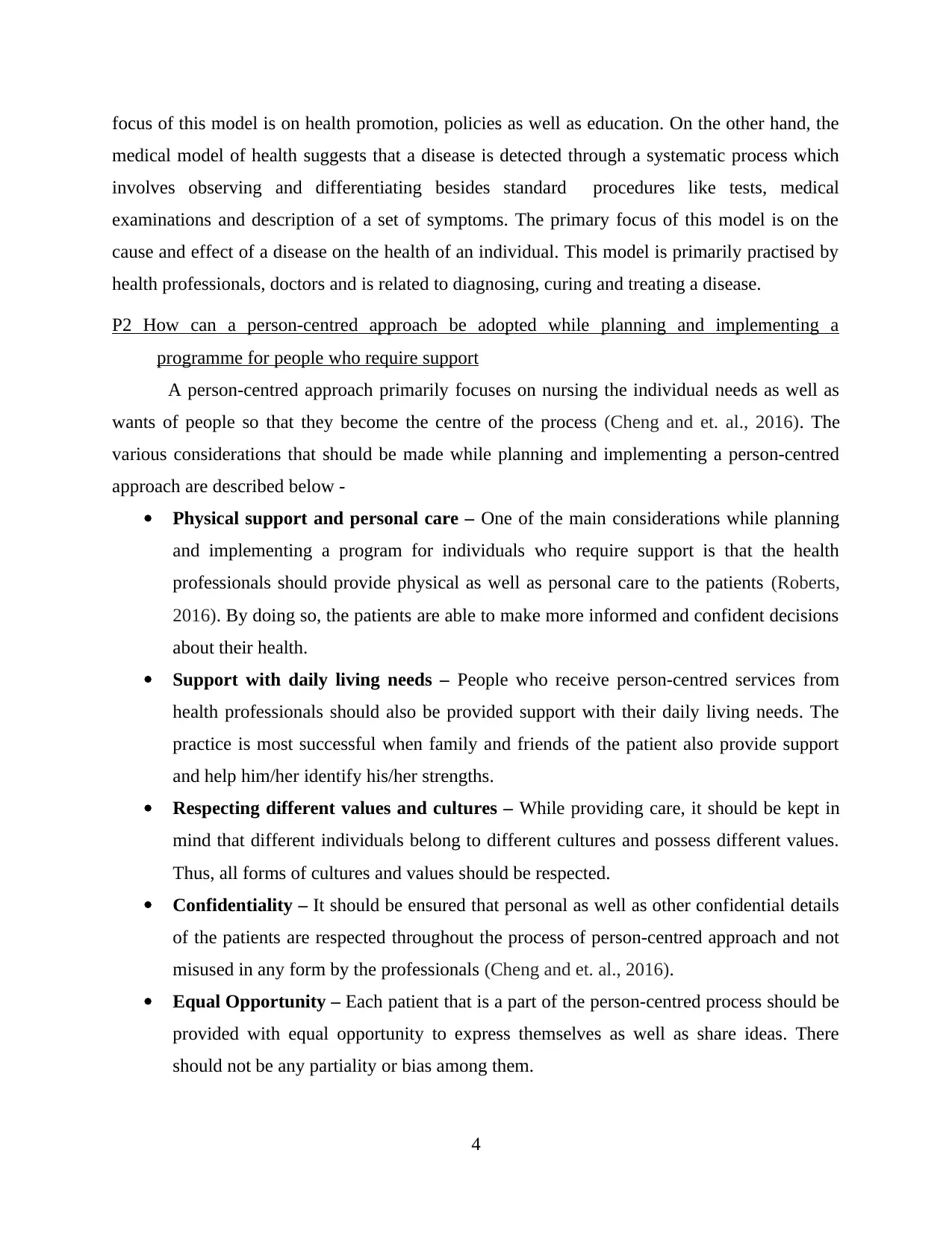
focus of this model is on health promotion, policies as well as education. On the other hand, the
medical model of health suggests that a disease is detected through a systematic process which
involves observing and differentiating besides standard procedures like tests, medical
examinations and description of a set of symptoms. The primary focus of this model is on the
cause and effect of a disease on the health of an individual. This model is primarily practised by
health professionals, doctors and is related to diagnosing, curing and treating a disease.
P2 How can a person-centred approach be adopted while planning and implementing a
programme for people who require support
A person-centred approach primarily focuses on nursing the individual needs as well as
wants of people so that they become the centre of the process (Cheng and et. al., 2016). The
various considerations that should be made while planning and implementing a person-centred
approach are described below -
Physical support and personal care – One of the main considerations while planning
and implementing a program for individuals who require support is that the health
professionals should provide physical as well as personal care to the patients (Roberts,
2016). By doing so, the patients are able to make more informed and confident decisions
about their health.
Support with daily living needs – People who receive person-centred services from
health professionals should also be provided support with their daily living needs. The
practice is most successful when family and friends of the patient also provide support
and help him/her identify his/her strengths.
Respecting different values and cultures – While providing care, it should be kept in
mind that different individuals belong to different cultures and possess different values.
Thus, all forms of cultures and values should be respected.
Confidentiality – It should be ensured that personal as well as other confidential details
of the patients are respected throughout the process of person-centred approach and not
misused in any form by the professionals (Cheng and et. al., 2016).
Equal Opportunity – Each patient that is a part of the person-centred process should be
provided with equal opportunity to express themselves as well as share ideas. There
should not be any partiality or bias among them.
4
medical model of health suggests that a disease is detected through a systematic process which
involves observing and differentiating besides standard procedures like tests, medical
examinations and description of a set of symptoms. The primary focus of this model is on the
cause and effect of a disease on the health of an individual. This model is primarily practised by
health professionals, doctors and is related to diagnosing, curing and treating a disease.
P2 How can a person-centred approach be adopted while planning and implementing a
programme for people who require support
A person-centred approach primarily focuses on nursing the individual needs as well as
wants of people so that they become the centre of the process (Cheng and et. al., 2016). The
various considerations that should be made while planning and implementing a person-centred
approach are described below -
Physical support and personal care – One of the main considerations while planning
and implementing a program for individuals who require support is that the health
professionals should provide physical as well as personal care to the patients (Roberts,
2016). By doing so, the patients are able to make more informed and confident decisions
about their health.
Support with daily living needs – People who receive person-centred services from
health professionals should also be provided support with their daily living needs. The
practice is most successful when family and friends of the patient also provide support
and help him/her identify his/her strengths.
Respecting different values and cultures – While providing care, it should be kept in
mind that different individuals belong to different cultures and possess different values.
Thus, all forms of cultures and values should be respected.
Confidentiality – It should be ensured that personal as well as other confidential details
of the patients are respected throughout the process of person-centred approach and not
misused in any form by the professionals (Cheng and et. al., 2016).
Equal Opportunity – Each patient that is a part of the person-centred process should be
provided with equal opportunity to express themselves as well as share ideas. There
should not be any partiality or bias among them.
4
Paraphrase This Document
Need a fresh take? Get an instant paraphrase of this document with our AI Paraphraser
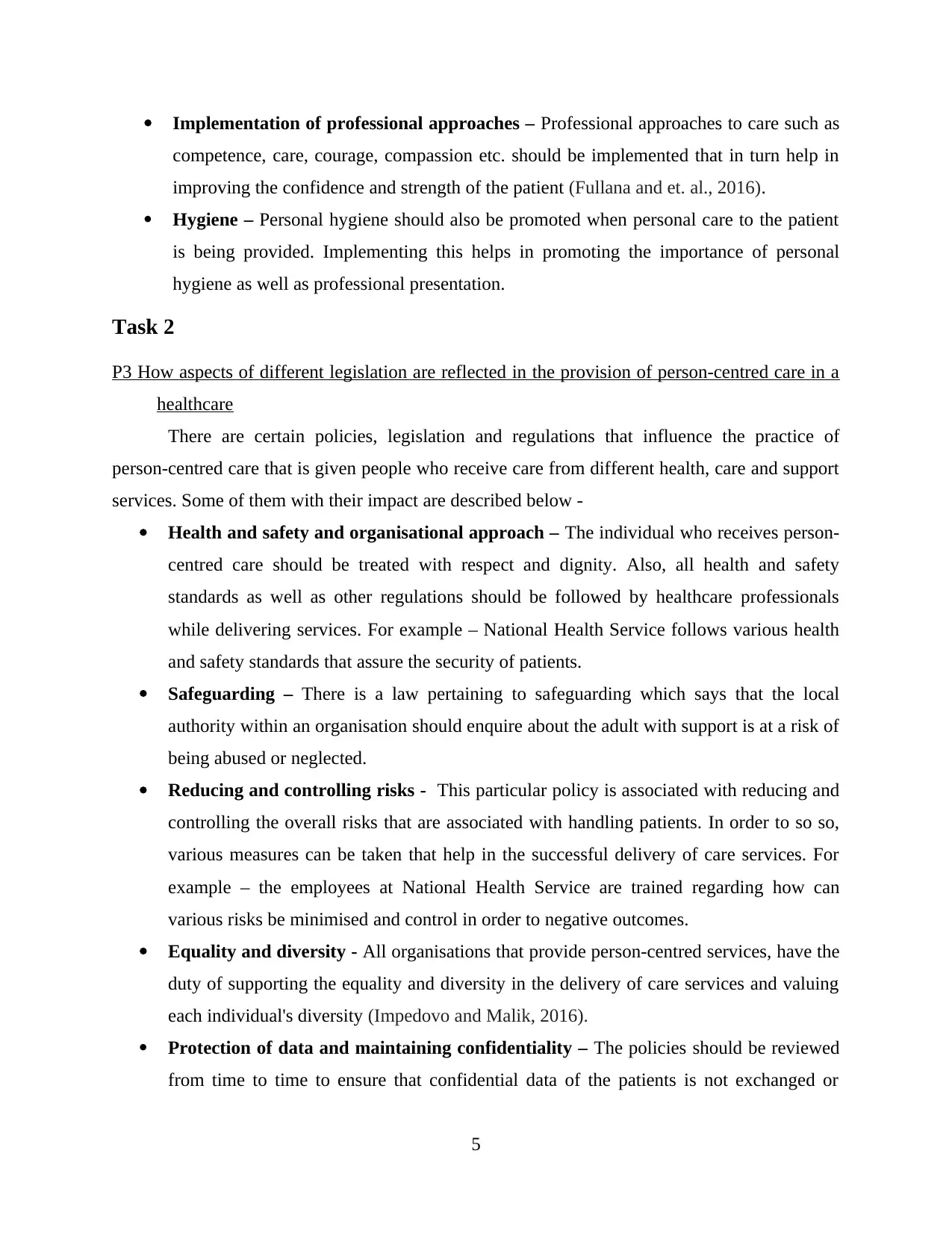
Implementation of professional approaches – Professional approaches to care such as
competence, care, courage, compassion etc. should be implemented that in turn help in
improving the confidence and strength of the patient (Fullana and et. al., 2016).
Hygiene – Personal hygiene should also be promoted when personal care to the patient
is being provided. Implementing this helps in promoting the importance of personal
hygiene as well as professional presentation.
Task 2
P3 How aspects of different legislation are reflected in the provision of person-centred care in a
healthcare
There are certain policies, legislation and regulations that influence the practice of
person-centred care that is given people who receive care from different health, care and support
services. Some of them with their impact are described below -
Health and safety and organisational approach – The individual who receives person-
centred care should be treated with respect and dignity. Also, all health and safety
standards as well as other regulations should be followed by healthcare professionals
while delivering services. For example – National Health Service follows various health
and safety standards that assure the security of patients.
Safeguarding – There is a law pertaining to safeguarding which says that the local
authority within an organisation should enquire about the adult with support is at a risk of
being abused or neglected.
Reducing and controlling risks - This particular policy is associated with reducing and
controlling the overall risks that are associated with handling patients. In order to so so,
various measures can be taken that help in the successful delivery of care services. For
example – the employees at National Health Service are trained regarding how can
various risks be minimised and control in order to negative outcomes.
Equality and diversity - All organisations that provide person-centred services, have the
duty of supporting the equality and diversity in the delivery of care services and valuing
each individual's diversity (Impedovo and Malik, 2016).
Protection of data and maintaining confidentiality – The policies should be reviewed
from time to time to ensure that confidential data of the patients is not exchanged or
5
competence, care, courage, compassion etc. should be implemented that in turn help in
improving the confidence and strength of the patient (Fullana and et. al., 2016).
Hygiene – Personal hygiene should also be promoted when personal care to the patient
is being provided. Implementing this helps in promoting the importance of personal
hygiene as well as professional presentation.
Task 2
P3 How aspects of different legislation are reflected in the provision of person-centred care in a
healthcare
There are certain policies, legislation and regulations that influence the practice of
person-centred care that is given people who receive care from different health, care and support
services. Some of them with their impact are described below -
Health and safety and organisational approach – The individual who receives person-
centred care should be treated with respect and dignity. Also, all health and safety
standards as well as other regulations should be followed by healthcare professionals
while delivering services. For example – National Health Service follows various health
and safety standards that assure the security of patients.
Safeguarding – There is a law pertaining to safeguarding which says that the local
authority within an organisation should enquire about the adult with support is at a risk of
being abused or neglected.
Reducing and controlling risks - This particular policy is associated with reducing and
controlling the overall risks that are associated with handling patients. In order to so so,
various measures can be taken that help in the successful delivery of care services. For
example – the employees at National Health Service are trained regarding how can
various risks be minimised and control in order to negative outcomes.
Equality and diversity - All organisations that provide person-centred services, have the
duty of supporting the equality and diversity in the delivery of care services and valuing
each individual's diversity (Impedovo and Malik, 2016).
Protection of data and maintaining confidentiality – The policies should be reviewed
from time to time to ensure that confidential data of the patients is not exchanged or
5
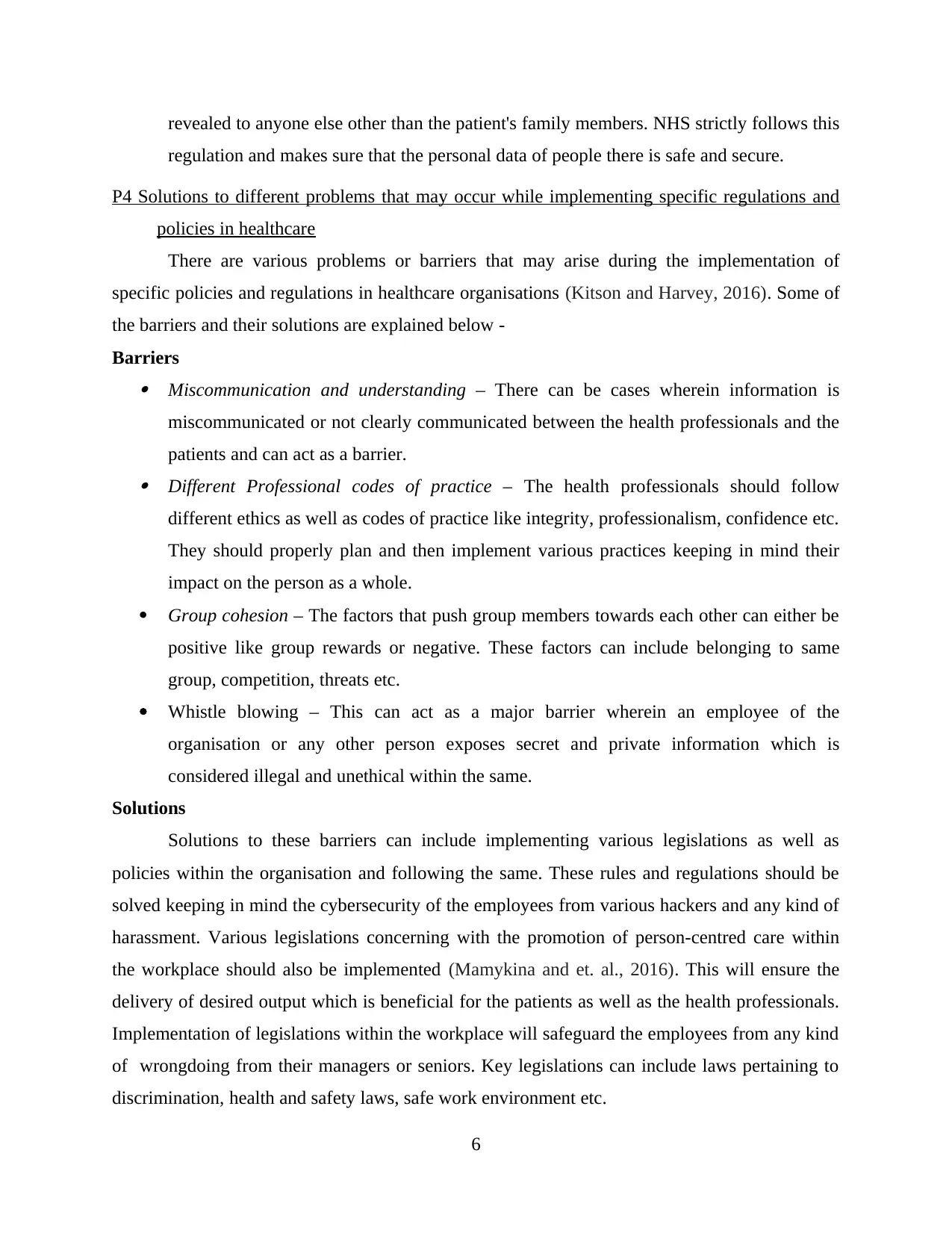
revealed to anyone else other than the patient's family members. NHS strictly follows this
regulation and makes sure that the personal data of people there is safe and secure.
P4 Solutions to different problems that may occur while implementing specific regulations and
policies in healthcare
There are various problems or barriers that may arise during the implementation of
specific policies and regulations in healthcare organisations (Kitson and Harvey, 2016). Some of
the barriers and their solutions are explained below -
Barriers Miscommunication and understanding – There can be cases wherein information is
miscommunicated or not clearly communicated between the health professionals and the
patients and can act as a barrier. Different Professional codes of practice – The health professionals should follow
different ethics as well as codes of practice like integrity, professionalism, confidence etc.
They should properly plan and then implement various practices keeping in mind their
impact on the person as a whole.
Group cohesion – The factors that push group members towards each other can either be
positive like group rewards or negative. These factors can include belonging to same
group, competition, threats etc.
Whistle blowing – This can act as a major barrier wherein an employee of the
organisation or any other person exposes secret and private information which is
considered illegal and unethical within the same.
Solutions
Solutions to these barriers can include implementing various legislations as well as
policies within the organisation and following the same. These rules and regulations should be
solved keeping in mind the cybersecurity of the employees from various hackers and any kind of
harassment. Various legislations concerning with the promotion of person-centred care within
the workplace should also be implemented (Mamykina and et. al., 2016). This will ensure the
delivery of desired output which is beneficial for the patients as well as the health professionals.
Implementation of legislations within the workplace will safeguard the employees from any kind
of wrongdoing from their managers or seniors. Key legislations can include laws pertaining to
discrimination, health and safety laws, safe work environment etc.
6
regulation and makes sure that the personal data of people there is safe and secure.
P4 Solutions to different problems that may occur while implementing specific regulations and
policies in healthcare
There are various problems or barriers that may arise during the implementation of
specific policies and regulations in healthcare organisations (Kitson and Harvey, 2016). Some of
the barriers and their solutions are explained below -
Barriers Miscommunication and understanding – There can be cases wherein information is
miscommunicated or not clearly communicated between the health professionals and the
patients and can act as a barrier. Different Professional codes of practice – The health professionals should follow
different ethics as well as codes of practice like integrity, professionalism, confidence etc.
They should properly plan and then implement various practices keeping in mind their
impact on the person as a whole.
Group cohesion – The factors that push group members towards each other can either be
positive like group rewards or negative. These factors can include belonging to same
group, competition, threats etc.
Whistle blowing – This can act as a major barrier wherein an employee of the
organisation or any other person exposes secret and private information which is
considered illegal and unethical within the same.
Solutions
Solutions to these barriers can include implementing various legislations as well as
policies within the organisation and following the same. These rules and regulations should be
solved keeping in mind the cybersecurity of the employees from various hackers and any kind of
harassment. Various legislations concerning with the promotion of person-centred care within
the workplace should also be implemented (Mamykina and et. al., 2016). This will ensure the
delivery of desired output which is beneficial for the patients as well as the health professionals.
Implementation of legislations within the workplace will safeguard the employees from any kind
of wrongdoing from their managers or seniors. Key legislations can include laws pertaining to
discrimination, health and safety laws, safe work environment etc.
6
⊘ This is a preview!⊘
Do you want full access?
Subscribe today to unlock all pages.

Trusted by 1+ million students worldwide
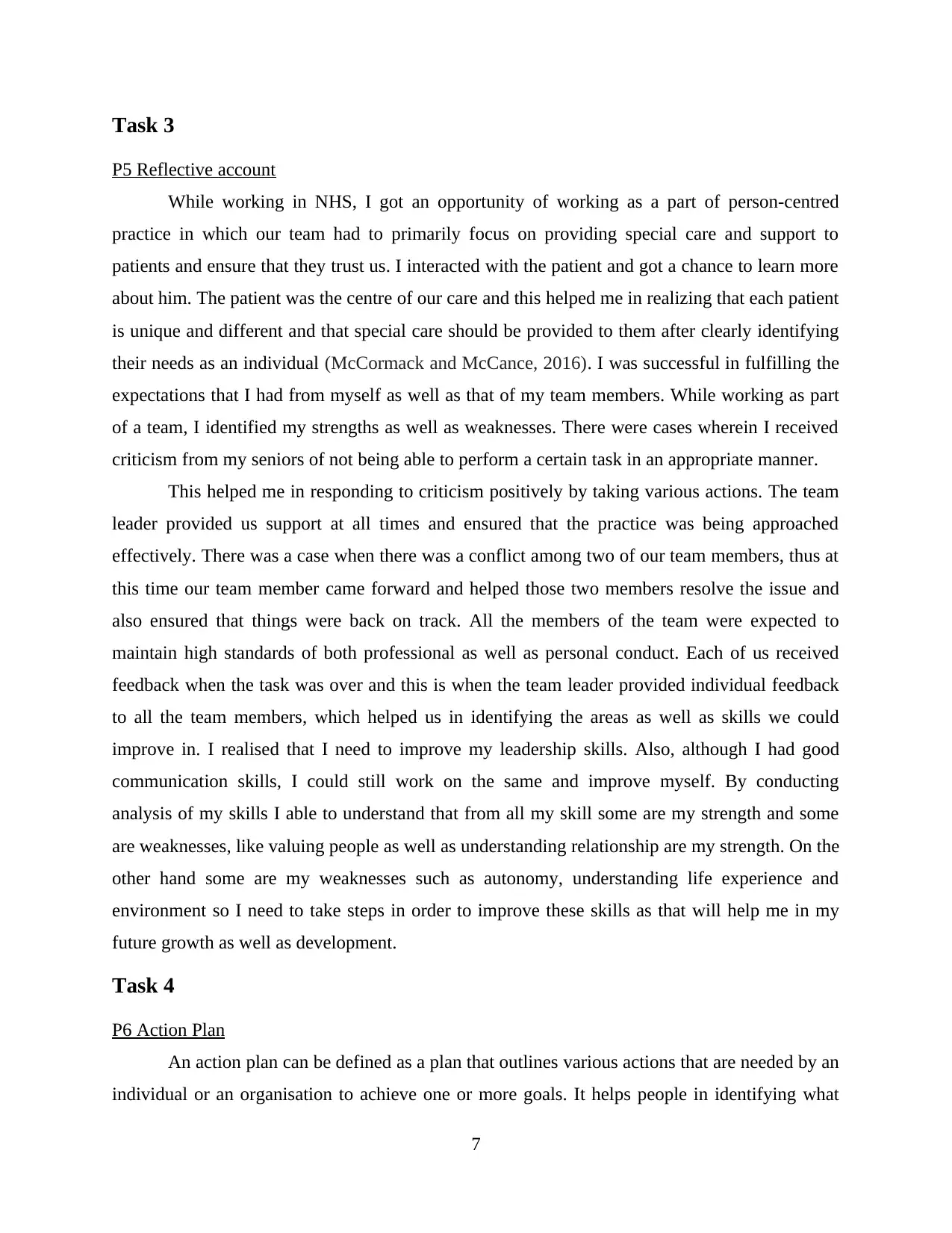
Task 3
P5 Reflective account
While working in NHS, I got an opportunity of working as a part of person-centred
practice in which our team had to primarily focus on providing special care and support to
patients and ensure that they trust us. I interacted with the patient and got a chance to learn more
about him. The patient was the centre of our care and this helped me in realizing that each patient
is unique and different and that special care should be provided to them after clearly identifying
their needs as an individual (McCormack and McCance, 2016). I was successful in fulfilling the
expectations that I had from myself as well as that of my team members. While working as part
of a team, I identified my strengths as well as weaknesses. There were cases wherein I received
criticism from my seniors of not being able to perform a certain task in an appropriate manner.
This helped me in responding to criticism positively by taking various actions. The team
leader provided us support at all times and ensured that the practice was being approached
effectively. There was a case when there was a conflict among two of our team members, thus at
this time our team member came forward and helped those two members resolve the issue and
also ensured that things were back on track. All the members of the team were expected to
maintain high standards of both professional as well as personal conduct. Each of us received
feedback when the task was over and this is when the team leader provided individual feedback
to all the team members, which helped us in identifying the areas as well as skills we could
improve in. I realised that I need to improve my leadership skills. Also, although I had good
communication skills, I could still work on the same and improve myself. By conducting
analysis of my skills I able to understand that from all my skill some are my strength and some
are weaknesses, like valuing people as well as understanding relationship are my strength. On the
other hand some are my weaknesses such as autonomy, understanding life experience and
environment so I need to take steps in order to improve these skills as that will help me in my
future growth as well as development.
Task 4
P6 Action Plan
An action plan can be defined as a plan that outlines various actions that are needed by an
individual or an organisation to achieve one or more goals. It helps people in identifying what
7
P5 Reflective account
While working in NHS, I got an opportunity of working as a part of person-centred
practice in which our team had to primarily focus on providing special care and support to
patients and ensure that they trust us. I interacted with the patient and got a chance to learn more
about him. The patient was the centre of our care and this helped me in realizing that each patient
is unique and different and that special care should be provided to them after clearly identifying
their needs as an individual (McCormack and McCance, 2016). I was successful in fulfilling the
expectations that I had from myself as well as that of my team members. While working as part
of a team, I identified my strengths as well as weaknesses. There were cases wherein I received
criticism from my seniors of not being able to perform a certain task in an appropriate manner.
This helped me in responding to criticism positively by taking various actions. The team
leader provided us support at all times and ensured that the practice was being approached
effectively. There was a case when there was a conflict among two of our team members, thus at
this time our team member came forward and helped those two members resolve the issue and
also ensured that things were back on track. All the members of the team were expected to
maintain high standards of both professional as well as personal conduct. Each of us received
feedback when the task was over and this is when the team leader provided individual feedback
to all the team members, which helped us in identifying the areas as well as skills we could
improve in. I realised that I need to improve my leadership skills. Also, although I had good
communication skills, I could still work on the same and improve myself. By conducting
analysis of my skills I able to understand that from all my skill some are my strength and some
are weaknesses, like valuing people as well as understanding relationship are my strength. On the
other hand some are my weaknesses such as autonomy, understanding life experience and
environment so I need to take steps in order to improve these skills as that will help me in my
future growth as well as development.
Task 4
P6 Action Plan
An action plan can be defined as a plan that outlines various actions that are needed by an
individual or an organisation to achieve one or more goals. It helps people in identifying what
7
Paraphrase This Document
Need a fresh take? Get an instant paraphrase of this document with our AI Paraphraser
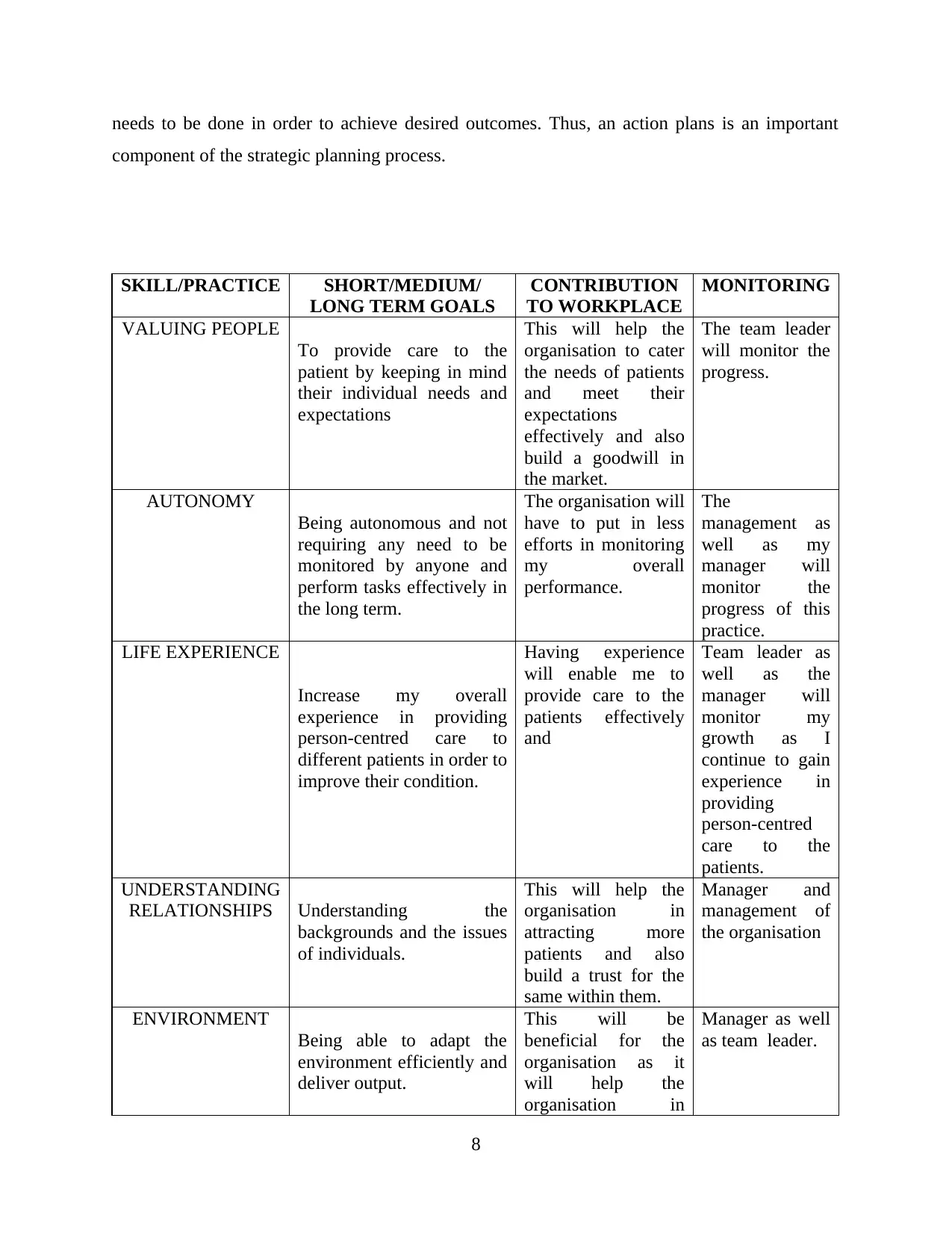
needs to be done in order to achieve desired outcomes. Thus, an action plans is an important
component of the strategic planning process.
SKILL/PRACTICE SHORT/MEDIUM/
LONG TERM GOALS
CONTRIBUTION
TO WORKPLACE
MONITORING
VALUING PEOPLE
To provide care to the
patient by keeping in mind
their individual needs and
expectations
This will help the
organisation to cater
the needs of patients
and meet their
expectations
effectively and also
build a goodwill in
the market.
The team leader
will monitor the
progress.
AUTONOMY
Being autonomous and not
requiring any need to be
monitored by anyone and
perform tasks effectively in
the long term.
The organisation will
have to put in less
efforts in monitoring
my overall
performance.
The
management as
well as my
manager will
monitor the
progress of this
practice.
LIFE EXPERIENCE
Increase my overall
experience in providing
person-centred care to
different patients in order to
improve their condition.
Having experience
will enable me to
provide care to the
patients effectively
and
Team leader as
well as the
manager will
monitor my
growth as I
continue to gain
experience in
providing
person-centred
care to the
patients.
UNDERSTANDING
RELATIONSHIPS Understanding the
backgrounds and the issues
of individuals.
This will help the
organisation in
attracting more
patients and also
build a trust for the
same within them.
Manager and
management of
the organisation
ENVIRONMENT
Being able to adapt the
environment efficiently and
deliver output.
This will be
beneficial for the
organisation as it
will help the
organisation in
Manager as well
as team leader.
8
component of the strategic planning process.
SKILL/PRACTICE SHORT/MEDIUM/
LONG TERM GOALS
CONTRIBUTION
TO WORKPLACE
MONITORING
VALUING PEOPLE
To provide care to the
patient by keeping in mind
their individual needs and
expectations
This will help the
organisation to cater
the needs of patients
and meet their
expectations
effectively and also
build a goodwill in
the market.
The team leader
will monitor the
progress.
AUTONOMY
Being autonomous and not
requiring any need to be
monitored by anyone and
perform tasks effectively in
the long term.
The organisation will
have to put in less
efforts in monitoring
my overall
performance.
The
management as
well as my
manager will
monitor the
progress of this
practice.
LIFE EXPERIENCE
Increase my overall
experience in providing
person-centred care to
different patients in order to
improve their condition.
Having experience
will enable me to
provide care to the
patients effectively
and
Team leader as
well as the
manager will
monitor my
growth as I
continue to gain
experience in
providing
person-centred
care to the
patients.
UNDERSTANDING
RELATIONSHIPS Understanding the
backgrounds and the issues
of individuals.
This will help the
organisation in
attracting more
patients and also
build a trust for the
same within them.
Manager and
management of
the organisation
ENVIRONMENT
Being able to adapt the
environment efficiently and
deliver output.
This will be
beneficial for the
organisation as it
will help the
organisation in
Manager as well
as team leader.
8
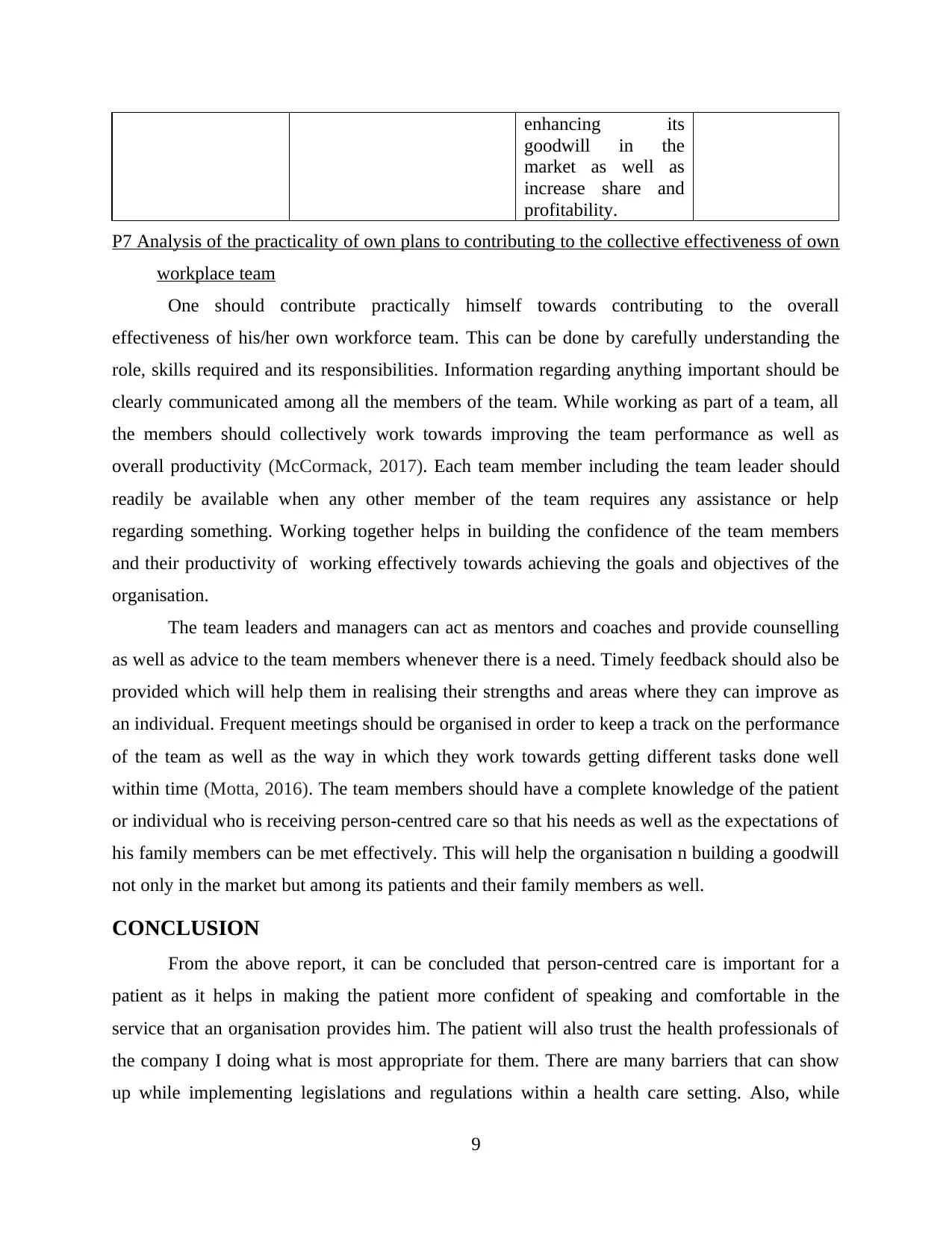
enhancing its
goodwill in the
market as well as
increase share and
profitability.
P7 Analysis of the practicality of own plans to contributing to the collective effectiveness of own
workplace team
One should contribute practically himself towards contributing to the overall
effectiveness of his/her own workforce team. This can be done by carefully understanding the
role, skills required and its responsibilities. Information regarding anything important should be
clearly communicated among all the members of the team. While working as part of a team, all
the members should collectively work towards improving the team performance as well as
overall productivity (McCormack, 2017). Each team member including the team leader should
readily be available when any other member of the team requires any assistance or help
regarding something. Working together helps in building the confidence of the team members
and their productivity of working effectively towards achieving the goals and objectives of the
organisation.
The team leaders and managers can act as mentors and coaches and provide counselling
as well as advice to the team members whenever there is a need. Timely feedback should also be
provided which will help them in realising their strengths and areas where they can improve as
an individual. Frequent meetings should be organised in order to keep a track on the performance
of the team as well as the way in which they work towards getting different tasks done well
within time (Motta, 2016). The team members should have a complete knowledge of the patient
or individual who is receiving person-centred care so that his needs as well as the expectations of
his family members can be met effectively. This will help the organisation n building a goodwill
not only in the market but among its patients and their family members as well.
CONCLUSION
From the above report, it can be concluded that person-centred care is important for a
patient as it helps in making the patient more confident of speaking and comfortable in the
service that an organisation provides him. The patient will also trust the health professionals of
the company I doing what is most appropriate for them. There are many barriers that can show
up while implementing legislations and regulations within a health care setting. Also, while
9
goodwill in the
market as well as
increase share and
profitability.
P7 Analysis of the practicality of own plans to contributing to the collective effectiveness of own
workplace team
One should contribute practically himself towards contributing to the overall
effectiveness of his/her own workforce team. This can be done by carefully understanding the
role, skills required and its responsibilities. Information regarding anything important should be
clearly communicated among all the members of the team. While working as part of a team, all
the members should collectively work towards improving the team performance as well as
overall productivity (McCormack, 2017). Each team member including the team leader should
readily be available when any other member of the team requires any assistance or help
regarding something. Working together helps in building the confidence of the team members
and their productivity of working effectively towards achieving the goals and objectives of the
organisation.
The team leaders and managers can act as mentors and coaches and provide counselling
as well as advice to the team members whenever there is a need. Timely feedback should also be
provided which will help them in realising their strengths and areas where they can improve as
an individual. Frequent meetings should be organised in order to keep a track on the performance
of the team as well as the way in which they work towards getting different tasks done well
within time (Motta, 2016). The team members should have a complete knowledge of the patient
or individual who is receiving person-centred care so that his needs as well as the expectations of
his family members can be met effectively. This will help the organisation n building a goodwill
not only in the market but among its patients and their family members as well.
CONCLUSION
From the above report, it can be concluded that person-centred care is important for a
patient as it helps in making the patient more confident of speaking and comfortable in the
service that an organisation provides him. The patient will also trust the health professionals of
the company I doing what is most appropriate for them. There are many barriers that can show
up while implementing legislations and regulations within a health care setting. Also, while
9
⊘ This is a preview!⊘
Do you want full access?
Subscribe today to unlock all pages.

Trusted by 1+ million students worldwide

working as part of a team, the members get a chance to identify their strengths and different
areas that can be worked up in order to improve. This is when an action plan can be used to
attain various goals through systematic steps.
10
areas that can be worked up in order to improve. This is when an action plan can be used to
attain various goals through systematic steps.
10
Paraphrase This Document
Need a fresh take? Get an instant paraphrase of this document with our AI Paraphraser
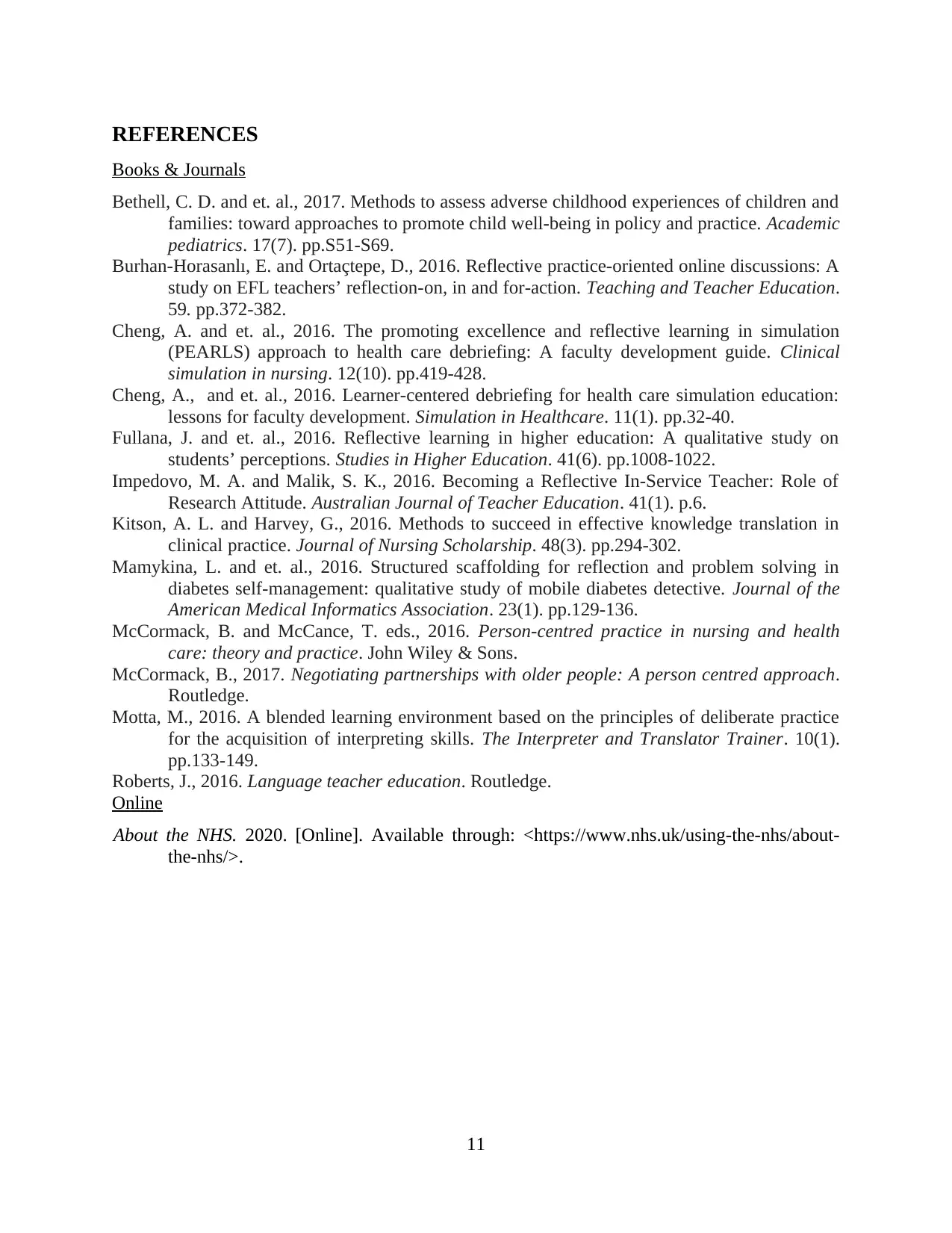
REFERENCES
Books & Journals
Bethell, C. D. and et. al., 2017. Methods to assess adverse childhood experiences of children and
families: toward approaches to promote child well-being in policy and practice. Academic
pediatrics. 17(7). pp.S51-S69.
Burhan-Horasanlı, E. and Ortaçtepe, D., 2016. Reflective practice-oriented online discussions: A
study on EFL teachers’ reflection-on, in and for-action. Teaching and Teacher Education.
59. pp.372-382.
Cheng, A. and et. al., 2016. The promoting excellence and reflective learning in simulation
(PEARLS) approach to health care debriefing: A faculty development guide. Clinical
simulation in nursing. 12(10). pp.419-428.
Cheng, A., and et. al., 2016. Learner-centered debriefing for health care simulation education:
lessons for faculty development. Simulation in Healthcare. 11(1). pp.32-40.
Fullana, J. and et. al., 2016. Reflective learning in higher education: A qualitative study on
students’ perceptions. Studies in Higher Education. 41(6). pp.1008-1022.
Impedovo, M. A. and Malik, S. K., 2016. Becoming a Reflective In-Service Teacher: Role of
Research Attitude. Australian Journal of Teacher Education. 41(1). p.6.
Kitson, A. L. and Harvey, G., 2016. Methods to succeed in effective knowledge translation in
clinical practice. Journal of Nursing Scholarship. 48(3). pp.294-302.
Mamykina, L. and et. al., 2016. Structured scaffolding for reflection and problem solving in
diabetes self-management: qualitative study of mobile diabetes detective. Journal of the
American Medical Informatics Association. 23(1). pp.129-136.
McCormack, B. and McCance, T. eds., 2016. Person-centred practice in nursing and health
care: theory and practice. John Wiley & Sons.
McCormack, B., 2017. Negotiating partnerships with older people: A person centred approach.
Routledge.
Motta, M., 2016. A blended learning environment based on the principles of deliberate practice
for the acquisition of interpreting skills. The Interpreter and Translator Trainer. 10(1).
pp.133-149.
Roberts, J., 2016. Language teacher education. Routledge.
Online
About the NHS. 2020. [Online]. Available through: <https://www.nhs.uk/using-the-nhs/about-
the-nhs/>.
11
Books & Journals
Bethell, C. D. and et. al., 2017. Methods to assess adverse childhood experiences of children and
families: toward approaches to promote child well-being in policy and practice. Academic
pediatrics. 17(7). pp.S51-S69.
Burhan-Horasanlı, E. and Ortaçtepe, D., 2016. Reflective practice-oriented online discussions: A
study on EFL teachers’ reflection-on, in and for-action. Teaching and Teacher Education.
59. pp.372-382.
Cheng, A. and et. al., 2016. The promoting excellence and reflective learning in simulation
(PEARLS) approach to health care debriefing: A faculty development guide. Clinical
simulation in nursing. 12(10). pp.419-428.
Cheng, A., and et. al., 2016. Learner-centered debriefing for health care simulation education:
lessons for faculty development. Simulation in Healthcare. 11(1). pp.32-40.
Fullana, J. and et. al., 2016. Reflective learning in higher education: A qualitative study on
students’ perceptions. Studies in Higher Education. 41(6). pp.1008-1022.
Impedovo, M. A. and Malik, S. K., 2016. Becoming a Reflective In-Service Teacher: Role of
Research Attitude. Australian Journal of Teacher Education. 41(1). p.6.
Kitson, A. L. and Harvey, G., 2016. Methods to succeed in effective knowledge translation in
clinical practice. Journal of Nursing Scholarship. 48(3). pp.294-302.
Mamykina, L. and et. al., 2016. Structured scaffolding for reflection and problem solving in
diabetes self-management: qualitative study of mobile diabetes detective. Journal of the
American Medical Informatics Association. 23(1). pp.129-136.
McCormack, B. and McCance, T. eds., 2016. Person-centred practice in nursing and health
care: theory and practice. John Wiley & Sons.
McCormack, B., 2017. Negotiating partnerships with older people: A person centred approach.
Routledge.
Motta, M., 2016. A blended learning environment based on the principles of deliberate practice
for the acquisition of interpreting skills. The Interpreter and Translator Trainer. 10(1).
pp.133-149.
Roberts, J., 2016. Language teacher education. Routledge.
Online
About the NHS. 2020. [Online]. Available through: <https://www.nhs.uk/using-the-nhs/about-
the-nhs/>.
11
1 out of 11
Related Documents
Your All-in-One AI-Powered Toolkit for Academic Success.
+13062052269
info@desklib.com
Available 24*7 on WhatsApp / Email
![[object Object]](/_next/static/media/star-bottom.7253800d.svg)
Unlock your academic potential
Copyright © 2020–2025 A2Z Services. All Rights Reserved. Developed and managed by ZUCOL.





